
views
X
Research source
Don’t worry! We’re here to walk you through some safe, effective ways to introduce your furry friends. Whether they’re a baby or an adult, any rat can become part of your family with a little patience, supervision, and TLC.
First Meeting

Quarantine the new rat for 2 weeks before starting introductions. Your first order of business is making sure your new rat is happy and healthy so it won’t spread any illness to the rest of your rat family. Just place your new rat in its own cage in a different room, away from your other rats. Generally, it takes up to 2 weeks for most rat illnesses to develop, so stay on the lookout for any symptoms during the quarantine period. Some unhealthy symptoms include a loss of appetite, scratching, frequent sneezes, fatigue, and hair loss.
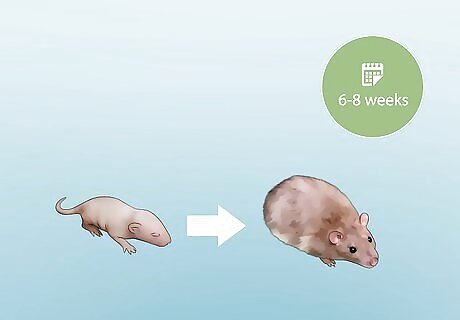
Wait 6-8 weeks after a rat is born to start introductions with older rats. Baby rats are very fragile and small and may have some trouble meeting the resident rat. With this in mind, wait until your rat is between 6 and 8 weeks old before starting any introductions. It may help to adopt 2 very young rats at the same time—they don’t have to be siblings. Adjusting to a new rat family can be stressful, especially if the resident rats aren’t very friendly. Two baby rats can support and comfort each other during the transition, which can make the process a lot easier. A rat is considered “young” or adolescent between 5 and 9 weeks. At 9 weeks, a rat is considered a young adult.
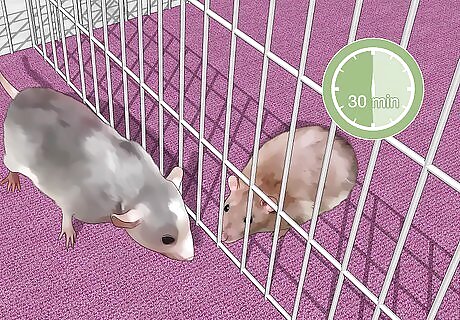
Place the rats next to each other in separate cages for 30 minutes. Set each rat into a separate wire cage so they can peek through the bars and interact with one another. Slide the cages far enough apart so the rats can’t stretch through the bars and attack each other. This way, your rats can get used to each other’s scent. Stay on the lookout for any signs of aggression, like puffed-up fur or an arched back. There isn’t a hard and fast timeline for introductions—it really depends on your rats’ personalities and temperaments. If 1 of your rats is especially aggressive, you might need to introduce them more gradually. As a general rule of thumb, you’ll have an easier time introducing 2 young rats. Unneutered, adult male rats are the most difficult to introduce, as they tend to be more aggressive. Older, more elderly rats tend to be calmer and more well-adjusted. In a study comparing rat and human lifespans, researchers found that a 6-month-old rat is 18 in human years, a 1-year-old rat is 30, a 2-year-old rat is actually 60, and a 3.5-year-old rat is 75.
Same Space Introductions
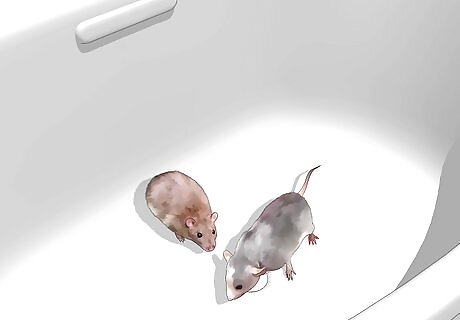
Introduce the rats in a neutral space. Find an open, empty spot, like a bathtub, where your rats can meet each other without getting territorial. Before setting your rats down, rub a drop of something potent on them, like vanilla essence—this can hide their natural scent, and help the introduction go more smoothly. Rats are very territorial, so a neutral space is a much safer option than your rat’s cage. Introduce your baby rat as soon as possible if it’ll be living with an adult male. Male rats get along pretty well with baby rats and aren’t very likely to attack. If you wait too long, your young rat might feel confident enough to stand up to the adult, which can lead to future conflict. To be safe, wait until the baby rat is at least 6 weeks old. If your rats seem to get along well, let them hang out for several hours in the neutral space as they get to know each other.

Watch for signs of extreme aggression if your rats start fighting. Don’t worry—fights between rats are perfectly normal and should be expected when your furry critters meet physically for the first time. Your rats might squeak, nip, chase, and/or even pin 1 down on the ground, but only intervene if 1 of the rats draws blood or acts extremely aggressive. Puffing fur, hissing, and biting are all signs of extreme aggression. In this event, your new rat might act scared by cowering or screeching. If a rat starts acting aggressively, drop a clean bath towel on top of it. Then, pick it up and away from the other rat. Ideally, your rats should be able to spend at least 30 minutes together without getting aggressive.
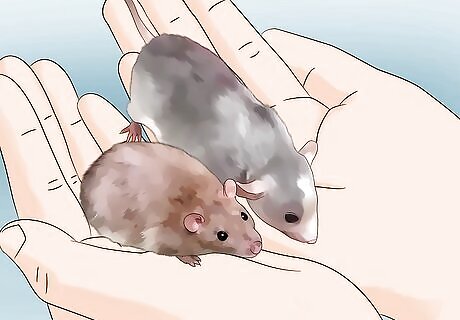
See if your rats can play in a familiar space for at least 30 minutes. Place your rats in a space that the older rat is used to, like a designated play area. Give the rats time to interact, but don’t be surprised if you notice some fighting at first. During this time, hold your new rat in your lap—this way, the other rat might get the message that the newcomer is a part of the family. Scold your veteran rat if it acts aggressively. You can tap the rat on the head with your finger, or place the rat in their cage for a time-out. Your rats should be able to interact for at least 30 minutes without fighting before you place them in the same cage.
Cohabitation

Clean out the cage where both rats will be staying. Take out all of the old toys and accessories and give them a good cleaning. Scrub the cage from top to bottom, and then slide some new bedding inside. Then, place the clean toys and accessories back inside afterward. You can clean your rat’s cage with soap and water. A cage for 2 rats should be at least 4 cubic feet (0.1 cubic meters), while a cage for 3 rats should be at least 8 cubic feet (0.23 cubic meters).
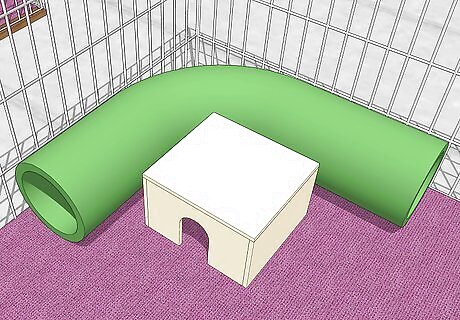
Put a new nestbox, pipe, tunnel, or glass jar in the cage for your new rat. This gives them a safe place to hide and hunker down in. Rats need a way to escape, especially if they don’t get along with another rat. Place a hiding space in your cage for each rat so your furry friends aren’t forced to share.

Get as many food bowls and water dishes as there are rats. This way, all of your rats have easy access to food and water whenever they’d like. Plus, they won’t have to share their eating and drinking space if they don’t want to!

Stick both rats in the clean, newly prepared cage. Keep a close eye on your pets as they adjust to both their surroundings and each other. Expect a bit of fighting and squabbling to happen—this is perfectly okay, and just part of the rats’ natural instincts. After a few days, your rats should be acclimated and used to each other. Split up your rats if you notice any signs of aggression that last longer than a few days. If your rats can’t develop a stable relationship, they might not be compatible housemates.



















Comments
0 comment